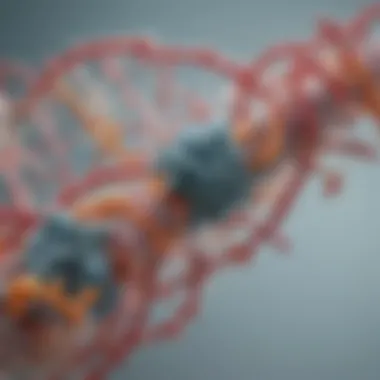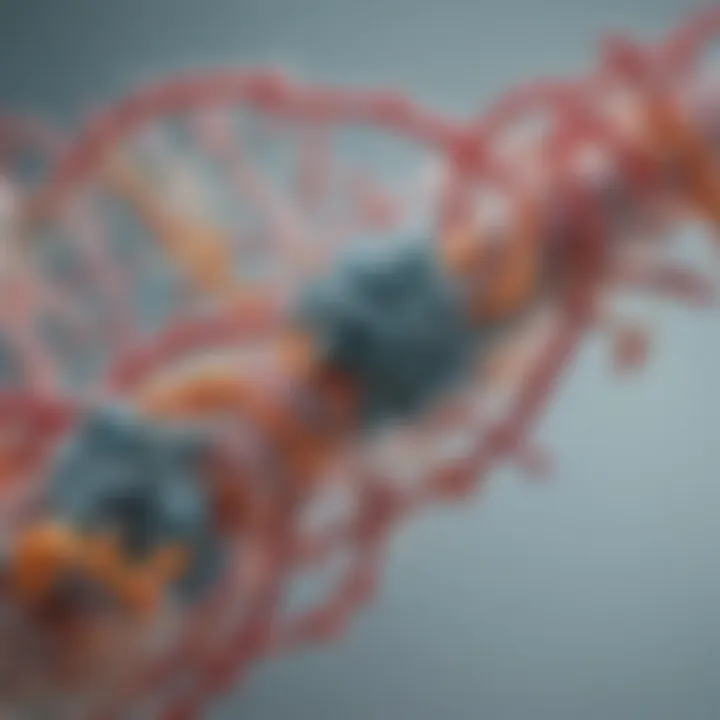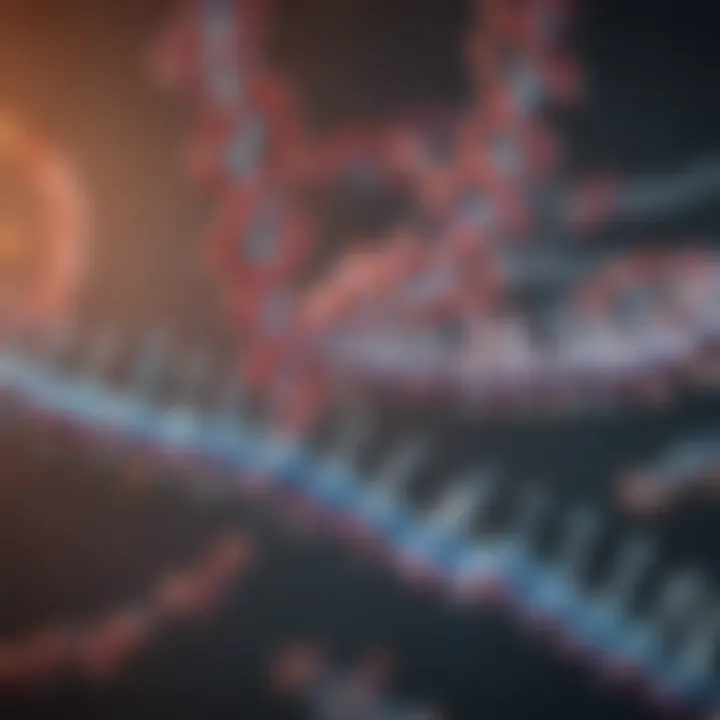NAD+: Key Player in Metabolism and Aging


Intro
In the intricate dance of life, NAD+ plays a pivotal role, yet many are unaware of its profound effects on cellular metabolism and the aging process. Nicotinamide adenine dinucleotide, or NAD+, is a coenzyme that exists in two forms: NAD+ and its reduced form, NADH. This biochemical compound is essential in various metabolic pathways, including energy production and DNA repair. Understanding its mechanics not only sheds light on fundamental biological processes but also opens doors for potential therapeutic interventions aimed at enhancing health and longevity.
As research progresses, it becomes increasingly clear that maintaining sufficient levels of NAD+ could be crucial for aging gracefully. Age-related declines in NAD+ synthesis have been linked to various diseases, highlighting the coenzyme's significant role in cellular health and function. Through this exploration, we aim to unpack the multiple facets of NAD+, examining its involvement in energy metabolism, cellular signaling, and the intricate dance between health and longevity.
Research Overview
Summary of Key Findings
Research into NAD+ has yielded several key insights:
- Energy Metabolism: NAD+ is vital for converting food into usable energy. It participates in redox reactions, which are central to cellular respiration.
- DNA Repair: This coenzyme is a critical player in mechanisms that repair damaged DNA, which, if left unchecked, can lead to malignancies and accelerate aging.
- Cellular Signaling: NAD+ influences various signaling pathways, notably those related to stress responses and inflammation, thereby contributing to cellular health.
Relevance to Current Scientific Discussions
In recent years, NAD+ has been thrust into the spotlight within the scientific community, drawing attention for its potential applications in anti-aging therapies. The growing body of evidence linking low NAD+ levels to age-related diseases has sparked discussions around supplementation and dietary strategies to enhance NAD+ biosynthesis. Furthermore, debates on the long-term effects of NAD+ precursors, such as nicotinamide riboside and nicotinamide mononucleotide, are gaining traction, highlighting a fertile ground for future research.
"NAD+ is not just a spectator in cellular metabolism; it is a conductor, orchestrating the symphony of biochemical reactions that sustain life."
Methodology
Research Design and Approach
The exploration of NAD+ in cellular metabolism often employs a multidisciplinary approach, combining biochemistry, molecular biology, and pharmacology. Researchers typically engage in both lab-based experiments and clinical trials to assess the effects of NAD+ modulation through various means, such as supplementation and lifestyle interventions.
Data Collection and Analysis Techniques
Data collection can include techniques such as:
- Chromatography: Used to measure NAD+ levels in biological samples.
- Mass Spectrometry: Provides insights into metabolic changes and the role of NAD+ precursors.
- Genetic Analysis: Helps understand the effects of NAD+ on gene expression and cellular function.
By integrating these advanced methodologies, researchers can uncover the broad implications of NAD+ for health and longevity, ultimately paving the way for novel therapeutic strategies.
Preface to NAD+
NAD+, or nicotinamide adenine dinucleotide, might sound like a mouthful, but its role in cellular metabolism and longevity is quite profound. Think of NAD+ as one of the unsung heroes in our cells. It's not just another compound; it's pivotal for various biochemical processes that keep our bodies running smoothly. Understanding what NAD+ is, how it works, and why it's essential can shine light on not only cellular function but also why longevity and health are intricately linked with this coenzyme.
Definition and Structure
To get to the nitty-gritty, NAD+ is a vital coenzyme present in every living cell. In its oxidized form, NAD+ serves as an electron carrier in redox reactions, facilitating the transfer of electrons during metabolic processes. Its molecular structure constitutes two nucleotides joined by their phosphate groups, featuring a ribose sugar in each.
These structural traits allow NAD+ to act as a shuttle for electrons, helping to convert energy from nutrients into a usable form. As cells break down nutrients through a process known as glycolysis, NAD+ picks up electrons and becomes reduced to NADH. This transformation is crucial as NADH then feeds into the electron transport chain, ultimately leading to ATP synthesis, the energy currency of the cell.
Historical Context
The story of NAD+ isn't just a modern scientific marvel; it spans across decades. Discovered in the early 20th century, NAD+ was first isolated from yeast by Arthur Harden and William John Young in 1906. Their groundbreaking work laid the foundation for understanding how enzymes involved in carbohydrate metabolism functioned.
Fast forward to the mid-20th century, and researchers uncovered that NAD+ was not only involved in energy metabolism but also played a role in other cellular processes, including DNA repair and gene expression. This evolving narrative displays the compound’s crucial role in cellular functions. Ironically, despite its importance, NAD+ often takes a backseat in discussions about metabolism compared to more commonly known elements like glucose or ATP.
As research advances into the 21st century, the nuances of NAD+ continue to unfold. Emerging studies suggest NAD+ levels decline with age, influencing health and longevity. The idea that boosting NAD+ might counteract age-related decline has captured the attention of both researchers and biohackers alike, fueling ongoing research into its therapeutic potential.
In summary, NAD+ represents a cornerstone of cellular metabolism. Its significance extends beyond basic metabolic processes, suggesting a deeper connection with aging and overall health. This journey through the definition and structure of NAD+ and its historical grounding paves the way for understanding its role in energy production and longevity.
Biochemical Pathways of NAD+
Understanding the biochemical pathways of NAD+ is key to grasping its role not just in cellular processes, but also its broader implications for health and longevity. NAD+ acts as a vital coenzyme, participating in redox reactions that are central to energy metabolism. These pathways are not just intricate biochemical processes; they are vital lifelines for cellular functions, influencing everything from energy production to DNA repair.
Synthesis of NAD+
NAD+ is synthesized in cells through several interconnected pathways. The de novo synthesis pathway allows it to be created from scratch using simple precursors like tryptophan. Alternatively, the salvage pathway reclaims NAD+ from its breakdown products, notably nicotinamide. An interesting consideration is the influence of dietary intake on these pathways. For instance, foods rich in niacin, such as turkey, chicken, and certain nuts directly contribute to NAD+ production, illustrating how nutrition can impact cellular metabolism on a fundamental level.
Key points regarding NAD+ synthesis include:
- Sources: Body can synthesize NAD+ from tryptophan or recycle it via the salvage pathway.
- Nutritional Impact: A diet lacking in these precursors can lead to reduced NAD+ levels, impacting overall health.
NAD+ and Cellular Metabolism
At the heart of cellular metabolism is NAD+, which plays an indispensable role in glycolysis, the citric acid cycle, and oxidative phosphorylation. By accepting and donating electrons, NAD+ helps convert food into usable energy in the form of ATP. The presence of NAD+ is critical during glycolysis where it facilitates the conversion of glucose into pyruvate.
Moreover, NAD+ acts as a shuttle that transfers electrons through the electron transport chain, ultimately leading to ATP synthesis in mitochondria. In this sense, the dynamics of NAD+ are closely tied to metabolic rate and energy efficiency of cells. This highlights its significance in conditions like obesity and metabolic syndrome, where NAD+ levels may be dysregulated. This leads to:


- Increased Energy Production: Adequate NAD+ supports ATP generation, crucial for cellular activities.
- Metabolic Disorders: Low NAD+ can contribute to energy imbalance and metabolic diseases.
NAD+ Role in Redox Reactions
Redox reactions are foundational for metabolic processes. NAD+ serves as a crucial oxidizing agent that enables the transformation of substrates in metabolic pathways. Its ability to switch between oxidized (NAD+) and reduced (NADH) states is key in facilitating energy production and maintaining cellular redox balance.
For instance, during fermentation in anaerobic conditions, NAD+ is regenerated when NADH is oxidized, sustaining glycolysis and allowing for ATP production even in the absence of oxygen. This is significant for both microorganism survival and tissue resilience under metabolic stress. Redox reactions involving NAD+ are crucial for:
- Energy Conversion: They allow cells to harvest energy from substrates efficiently.
- Protection Against Oxidative Stress: By contributing to the balance of reactive oxygen species, NAD+ helps in maintaining cellular integrity.
"NAD+ is not merely a coenzyme; it is the linchpin that connects cellular metabolism, energy production, and health resilience across diverse biological realms."
NAD+ and Energy Production
NAD+ plays a pivotal role in the generation of energy within cells, serving as a crucial coenzyme in various metabolic pathways. This section explores the significance of NAD+ in energy production, which is essential for maintaining cellular functions, supporting overall health, and possibly influencing longevity.
ATP Synthesis
ATP synthesis is at the core of cellular energy production, acting as the energy currency within our bodies. NAD+ is indispensable for this process because it acts as an electron carrier during cellular respiration, notably within the glycolytic pathway, the citric acid cycle, and oxidative phosphorylation. When glucose is metabolized, NAD+ accepts electrons, becoming reduced to NADH. This transformation is crucial as it enables the subsequent donation of electrons to the electron transport chain.
- Role in Glycolysis: During glycolysis, one molecule of glucose is converted into two molecules of pyruvate, yielding a net gain of two ATP molecules. Here, NAD+ is converted to NADH, facilitating the continuation of the cycle.
- Contribution to the Citric Acid Cycle: Once pyruvate enters the mitochondria, it is oxidized to acetyl-CoA before entering the citric acid cycle. NAD+ is again reduced to NADH, contributing more electrons for ATP production.
- Electron Transport Chain: Finally, within the mitochondrial inner membrane, NADH donates electrons to the electron transport chain. This step creates a proton gradient that drives ATP synthesis via ATP synthase. The whole interplay of NAD+ and ATP production showcases how NAD+ is not merely a participant but a fundamental player in the energy landscape of the cell.
Mitochondrial Function
Mitochondria are often described as the powerhouses of cells, and NAD+ is fundamental for proper mitochondrial function. This coenzyme helps in maintaining mitochondrial efficiency and integrity, impacting not only energy production but also several metabolic processes.
- Enhancing energy metabolism: NAD+ is closely tied to mitochondrial biogenesis and function—when NAD+ levels are sufficient, mitochondria efficiently produce ATP and maintain cellular homeostasis.
- Regulating Adaptive Responses: Mitochondria respond to energy demands by altering metabolic pathways, and NAD+ is part of this intricate regulatory mechanism. High NAD+ levels are associated with increased fatty acid oxidation and a shift toward oxidative metabolism, which can enhance energy availability during periods of increased demand.
- Linking to Cell Health: A decline in NAD+ levels can lead to mitochondrial dysfunction. This dysfunction is a hallmark of various age-related diseases, including neurodegenerative disorders. Thus, sustaining adequate NAD+ levels may contribute to healthier mitochondrial activity, potentially extending healthspan.
"Mitochondrial health is not just about energy. It's about resilience—how well a cell bounces back from stress, which often hinges on NAD+ levels."
The intricate connection between NAD+, ATP synthesis, and mitochondrial function emphasizes the coenzyme's vital role in energy production. By understanding these mechanisms, scientists can explore therapeutic avenues that could manipulate NAD+ levels to promote health and longevity.
The Impact of NAD+ on Aging
Understanding the effects of NAD+ levels on aging is crucial in the context of biological research and continual health advancements. NAD+ plays a pertinent role in many essential metabolic processes, and its depletion has been linked to various age-related diseases. As we age, the concentration of NAD+ in our cells tends to decline. This reduction can contribute to the aging process by undermining cellular functions which are vital to maintaining health and longevity.
NAD+ Levels in Aging
Research indicates that NAD+ levels fluctuate throughout life, with a noticeable dip in older age. This reduction influences several biological mechanisms, including energy metabolism and cellular repair processes. Maintaining adequate NAD+ levels has been posited as a form of potential rejuvenation. One way to visualize this is to consider it similar to a car running low on gas: when the tank is empty, everything slows down and may cease to operate effectively.
- Key observations on NAD+ in aging:
- Studies have shown that a decrease in NAD+ correlates with an increase in age-related disorders, such as diabetes and neurodegenerative diseases.
- Animal models suggest that enhancing NAD+ availability can reverse aspects of aging, highlighting its importance in the aging journey.
- Certain NAD+ precursors, like nicotinamide riboside, are being investigated for their abilities to bolster NAD+ levels in aging humans.
Therefore, the interplay between NAD+ concentrations and aging presents a vital avenue for potential interventions in age-related decline.
Cellular Senescence
Cellular senescence refers to a state where cells lose their ability to divide and function correctly. This phenomenon is often considered a biological marker of aging. NAD+ can influence the development of cellular senescence in fascinating ways. Without sufficient NAD+, cells might enter senescence earlier than they typically would, which effectively hampers tissue renewal and contributes to age-related pathologies.
- The relationship between NAD+ and cellular senescence includes:
- NAD+ is pivotal for the activity of sirtuins, a class of proteins that regulate cellular health and longevity. When NAD+ levels drop, sirtuins become less active, leading to increased susceptibility to stress and damage.
- Enhanced NAD+ availability can delay the onset of senescence in certain cells, resulting in improved functionality and longevity.
- Additionally, senescent cells secrete pro-inflammatory factors contributing to aging—by fostering higher NAD+ levels, we might diminish this inflammatory response.
In essence, the impacts of NAD+ on aging are multifaceted, wrapping around the vital essence of cellular activity and longevity. To reach a meaningful understanding of aging and potential therapeutic approaches, research should continue to investigate the intricate connections between NAD+, energy metabolism, and cellular health.
"Emerging evidence suggests that maintaining or restoring NAD+ levels could hold the key to combating age-related decline and enhancing longevity."
Following these insights, it becomes evident that NAD+ isn't just a simple molecule; it's a crucial player in the drama of aging.
NAD+ and DNA Repair Mechanisms
NAD+ plays a quintessential role in the intricate web of cellular functions, notably in the realm of DNA repair mechanisms. Our DNA, the blueprint of life, often suffers from various types of damage due to environmental factors, replication errors, or even intrinsic cellular processes. It is here that NAD+ steps in, acting like a trusty repairman, ensuring that cellular integrity is maintained and the genetic information remains intact. The importance of NAD+ in this context goes beyond mere repair; it serves as a crucial signaling molecule that influences cellular responses to stress, thereby impacting longevity and health.
NAD+-Dependent Repair Enzymes
The landscape of DNA repair is populated with specialized enzymes that rely on NAD+ to function optimally. Among the most notable are the poly(ADP-ribose) polymerases, often abbreviated as PARPs. This family of enzymes senses DNA damage and facilitates the recruitment of additional repair proteins to the site of the lesion. By catalyzing the transfer of ADP-ribose units from NAD+ to target proteins, PARPs create poly(ADP-ribose) chains, thus playing a significant part in the orchestration of the repair process.
The concept can be illustrated vividly: imagine walking into a room learning that a heavy object has fallen from a shelf, scattering items everywhere. The PARPs are akin to the swift organizer, utilizing the available tools (NAD+) to rectify the situation. In conditions where NAD+ levels are adequate, PARPs can efficiently execute their repair duties. However, in scenarios where NAD+ is scarce—often seen in aging or under stress—these enzymes may falter, resulting in incomplete repair and potential genomic instability, paving pathways for diseases like cancer.
- Key NAD+-Dependent Repair Enzymes:


- PARP1: The most studied and pivotal in single-strand break repair.
- PARP2: Works alongside PARP1 in DNA damage response.
- Sirtuins: These also utilize NAD+ and have roles in DNA repair but extend into regulating other cellular functions.
By maintaining a healthy NAD+ pool, cells can support the activities of these repair enzymes, promoting longevity and reducing the incidence of cellular senescence.
Implications for Cancer Biology
The relationship between NAD+ and DNA repair mechanisms has profound implications for cancer biology. Tumor cells often exhibit altered NAD+ metabolism, which can either bolster their survival or render them vulnerable, depending on how the balance is managed. High levels of PARP activity in cancer cells, for instance, can lead to rapid repair of DNA damage caused by chemotherapy treatments, making these cells resistant to the very drugs designed to destroy them.
Moreover, the exploitation of NAD+ pathways for therapeutic gain has gained traction in recent years. Researchers are exploring the use of PARP inhibitors in oncology, which specifically target cancer cells' reliance on NAD+-dependent repair while sparing normal cells that do not overexpress these pathways.
"Understanding how NAD+ interacts with DNA repair mechanisms offers a unique insight into possible therapeutic approaches that can enhance treatment efficacy and cancer patient outcomes."
This strategy hones in on the dynamic role of NAD+, positioning it not only as a vital player in maintaining genomic integrity but also as a potential target for innovative cancer therapies. It underscores the intricate balance between utilizing cellular repair mechanisms for survival while potentially exploiting vulnerabilities from an aberrant reliance on NAD+ in cancerous cells.
In summary, recognizing the critical link between NAD+, DNA repair enzymes, and cancer biology opens avenues for understanding the cellular processes that underlie disease and longevity. Leaning into this field could lead to more effective treatments and further unravel the complexities of cellular metabolism.
NAD+ in Cellular Signaling
NAD+ plays a significant role in cellular signaling, a multifaceted aspect of its function that extends beyond its traditional involvement in metabolic reactions. By participating in cellular signaling pathways, NAD+ influences various cellular processes crucial for maintaining cellular homeostasis and responding to environmental challenges. This section examines the importance of NAD+ in these signaling networks, emphasizing its interactions with critical proteins and the implications for health and disease.
NAD+ and Sirtuins
One of the key players in the realm of NAD+ signaling is sirtuins, a family of enzymes that have garnered considerable attention due to their involvement in regulating longevity, metabolism, and stress responses. Sirtuins—a group of proteins, including SIRT1, SIRT3, and SIRT6—depend on NAD+ for their enzymatic activity. The relationship between NAD+ and sirtuins is emblematic of how biochemical signaling can impact cellular fate.
Sirtuins act as deacetylases, removing acetyl groups from lysine residues on target proteins, which alters their function. This process does not just modify individual proteins; it potentially influences pathways related to energy metabolism and DNA repair. For instance, SIRT1, often dubbed a guardian of cellular health, activates in response to increased NAD+ levels and has been implicated in enhancing mitochondrial function and promoting metabolic flexibility.
The ability of sirtuins to sense NAD+ levels ties them intricately to the cellular state. High NAD+ levels can trigger sirtuin activity, promoting beneficial outcomes such as improved insulin sensitivity and reduced oxidative stress. In contrast, diminished NAD+ availability can hinder sirtuin function, leading to metabolic dysfunction and contributing to age-related diseases. Thus, the NAD+/sirtuin axis holds promise for interventions aimed at improving healthspan as people age.
NAD+ in Inflammation and Immunity
NAD+ is central not just to metabolic processes but also to immune responses. It influences various immune cell functions, playing pivotal roles in inflammation and host defense mechanisms. A fascinating aspect of NAD+ signaling within the immune system is its dual nature; while it can promote protective responses, it may also contribute to pathological inflammation when imbalances occur.
One significant pathway involves the regulation of immune cells by NAD+. Macrophages, for example, use NAD+ in the production of reactive oxygen species and the activation of signaling cascades necessary for immune activation. A sea of studies highlights how manipulating NAD+ levels can sway inflammatory responses. For instance, research has demonstrated that NAD+ depletion can lead to enhanced pro-inflammatory cytokine production. This highlights the potential risks of low NAD+ availability not only for metabolic health but also for effectively managing inflammation.
Conversely, an increase in NAD+ can enhance the function of anti-inflammatory pathways. Enhancing cellular NAD+ levels has shown promise in reducing chronic inflammation, a crucial factor in various conditions, including obesity, diabetes, and neurodegenerative diseases.
"NAD+ operates like a biochemical switch, turning on vital processes that sustain life and protect against disease."
Understanding these pathways opens doors for therapeutic strategies aimed at not just extending lifespan but improving health quality. Moving forward, targeted approaches that manipulate NAD+ levels offer potential pathways for innovation in treating age-related diseases and optimizing health outcomes.
NAD+ and the Microbiome
Understanding the interplay between NAD+ and the microbiome is becoming increasingly vital in the field of cellular metabolism and longevity. The gut microbiome, a complex community of microorganisms residing in our intestines, has numerous roles, from aiding digestion to influencing our immune system. One fascinating aspect of this relationship is how these microbes can affect levels of NAD+, a critical coenzyme necessary for cellular activities.
Microbial Production of NAD+ Precursors
Microbes have a remarkable ability to produce precursors that are essential for the synthesis of NAD+. The bacteria within our gut can convert dietary niacin (vitamin B3) and tryptophan into NAD+ through intricate biochemical pathways. Individuals with a diverse microbiome often show increased capacity to produce these precursors, which helps to maintain sufficient levels of NAD+ in the body. This process not only supports energy metabolism in our cells but also contributes to overall health. Research has indicated that certain strains of probiotics can significantly enhance the microbial production of NAD+ precursors. Thus, including these beneficial bacteria in our diet could serve as a practical strategy to bolster NAD+ levels naturally.
Role in Host-Microbe Interactions
The relationship between NAD+ and our microbiome is a two-way street. Not only do microbes assist in the production of NAD+ precursors, but NAD+ itself can also influence the composition of the microbial community in the gut. For instance, NAD+ regulates the activity of several signaling pathways that control inflammation and immune responses. A balanced level of NAD+ is crucial for maintaining a healthy microbiome.
- Impact on Gut Health: High NAD+ levels have been associated with reduced inflammation in the gut, which is beneficial for preventing dysbiosis, an imbalance in the microbial community that can lead to gastrointestinal issues.
- Immune Modulation: NAD+ plays a role in modulating immune responses, predominantly through its interaction with the sirtuin family of proteins. These proteins can react to microbial metabolites, thereby influencing the gut environment and maintaining immune homeostasis.
- Metabolic Benefits: A thriving microbiome can improve nutrient absorption, which in turn can enhance NAD+ synthesis and availability across tissues.
People have begun to appreciate the significant role of diet in shaping our microbiota. As such, consuming foods rich in NAD+ precursors, like meat, fish, dairy, and green leafy vegetables, alongside probiotic-rich foods, could create a favorable environment for health.
"The microbiome is like a dynamic orchestra, where the right balance and harmony among its players ensure optimal performance for the host's health."
Therapeutic Approaches to Modulate NAD+ Levels
In recent years, there has been an increasing interest in how we can modulate NAD+ levels for therapeutic purposes. Given its significant role in cellular metabolism, energy production, and even in the aging process, finding ways to boost NAD+ could enhance overall health and longevity. Insights from research in this area are painting a promising picture, shedding light on how we might influence biological pathways crucial for maintaining cellular health.
NAD+ Precursors and Supplements
NAD+ levels can decline due to various factors such as aging, stress, and environmental toxins. Fortunately, one key avenue for increasing NAD+ levels is through the use of precursors and supplements. Nicotinamide riboside (NR) and nicotinamide mononucleotide (NMN) are two of the most popular compounds that serve as precursors to NAD+. When ingested, these compounds enter cells and are converted into NAD+, thus potentially revitalizing cellular function.
Many studies indicate that supplementation can lead to improvements in metabolic health as well, including enhanced insulin sensitivity and improved muscle function. Especially in older individuals, elevated NAD+ levels from these supplements could support better cellular repair mechanisms and help combat age-related decline.
It’s essential, however, to approach supplementation with a critical mind. Not every product on the market has undergone rigorous testing or is backed by solid scientific findings, making careful selection crucial. A thorough understanding of dosages and potential side effects can also play a significant role in therapeutic efficacy.
"Harnessing NAD+ precursors like NR and NMN could be a game-changer in the quest for longevity and optimal health."


Lifestyle Interventions
Alongside supplementation, various lifestyle interventions can naturally boost NAD+ levels in the body. Regular physical activity tops the list; research highlights how exercise can stimulate the production of enzymes related to NAD+ synthesis. Striking a balance in diet also contributes; caloric restriction, for example, has shown promise in increasing NAD+ levels.
Moreover, incorporating foods rich in NAD+ precursors into daily meals is advisable. Foods like whole grains, green vegetables, and dairy products not only provide a nutrient boost but can also facilitate the body's NAD+ production.
As with any health approach, moderation is key. While enhancing NAD+ levels through lifestyle changes is appealing, it’s crucial to consult with healthcare professionals to tailor interventions to individual health profiles. Such personalized strategies could make all the difference in optimizing health outcomes.
In summary, the pathways through which we can modulate NAD+ levels are both intriguing and diverse, allowing for both pharmacological and lifestyle strategies that hold potential for improving health and longevity. It's a developing field that beckons further exploration and understanding.
NAD+ and Neurodegenerative Diseases
NAD+ plays a crucial role in the context of neurodegenerative diseases, marking it as a topic of significant relevance in cellular metabolism and longevity. The decline in NAD+ levels with age can often coincide with the onset of neurodegenerative disorders. These include Alzheimer's disease, Parkinson's disease, and Huntington's disease, where cellular dysfunction and energy depletion can lead to detrimental outcomes for neural health.
Impact on Neurodegeneration
The decline in NAD+ is not just a trivial detail; it contributes to a cascade of events that underlie neurodegeneration. One important area of focus is mitochondrial function. Mitochondria are the powerhouses of cells, responsible for producing ATP, the energy currency. They rely heavily on NAD+ to facilitate metabolic processes. When NAD+ levels drop, mitochondrial efficiency wanes, potentially leading to increased oxidative stress and neuronal cell death.
Researchers have pointed out that neurons are particularly susceptible to alterations in NAD+ levels. This vulnerability is because neurons have a high metabolic demand. When NAD+ concentrations decline, the neurons struggle to generate adequate energy, ultimately affecting cognitive functions.
Some studies have shown that restoration of NAD+ levels in cellular models can mitigate neurodegeneration. For instance, enhancing NAD+ availability helps stabilize mitochondrial activity, reduces inflammation, and combats oxidative insults—factors that typically precipitate neurodegenerative processes.
"Maintaining NAD+ levels is essential for promoting neuronal health and mitigating the decline associated with aging and neurodegeneration."
Potential for Therapeutic Development
Given its pivotal role, NAD+ is increasingly gaining attention as a target for therapeutic interventions aimed at neurodegenerative diseases. The idea of boosting NAD+ levels through dietary supplements or pharmaceutical agents is an emerging field of research.
Several promising NAD+ precursors, such as nicotinamide riboside and nicotinamide mononucleotide, have shown potential in preclinical models. These compounds are believed to enhance NAD+ biosynthesis, offering a way to replenish depleting NAD+ stores.
Additionally, there is a growing interest in lifestyle changes that may naturally boost NAD+ levels. Activities such as exercise and specific dietary choices, like maintaining a low-calorie diet, have been linked to increased NAD+ synthesis.
The exploration into how NAD+ modulation can affect neurodegeneration is just beginning, yet the results so far are encouraging. Trends indicate that there may be room for developing strategies to harness NAD+ effectively as a therapeutic agent, not only to slow neurodegeneration but perhaps even reverse some of its effects.
In summary, understanding the relationship between NAD+ and neurodegenerative diseases opens avenues for innovative therapeutic strategies. Enhancing NAD+ levels could emerge as a significant approach in managing or even preventing the onset of these challenging conditions, making it a critical area for future research.
Research Frontiers in NAD+ Biology
Understanding NAD+ and its complex role in various biological processes is essential in the realm of cellular metabolism and longevity. In recent years, advances in research have begun to unveil intriguing aspects of NAD+ that extend beyond basic metabolism, pointing towards its involvement in areas like stem cell biology, neurodegenerative diseases, and even aging itself. The significance of these emerging fields lies not only in their potential to redefine our comprehension of cellular health but also in their capacity to inform therapeutic interventions aimed at enhancing longevity.
NAD+ in Stem Cell Biology
Stem cells have an extraordinary ability to differentiate into various cell types, making them a cornerstone of regenerative medicine. Recent research highlights the pivotal role of NAD+ in maintaining stem cell function. The levels of NAD+ significantly influence stem cell pluripotency and the cells’ capacity to self-renew.
Studies demonstrate that a decline in NAD+ levels disrupts the balance between differentiation and self-renewal, leading to diminished regenerative potential. In particular, mesenchymal stem cells, which can differentiate into a range of tissues, exhibit lower NAD+ levels with age. Restoring these levels has shown promise in potentially delaying the aging of these cells and maintaining their regenerative capabilities.
"The study of NAD+ in stem cell biology may provide vital clues not only to the aging process but also to how we can harness the powerful regenerative capabilities of stem cells."
On a molecular level, the regulation of NAD+ impacts various pathways and enzymes, such as sirtuins, which are crucial for maintaining cellular integrity. These connections hint at a broader, more complex network where NAD+ acts as a central player in stem cell health, linking metabolism to stem cell functionality.
Future Directions and Opportunities
The future of NAD+ research is ripe with opportunities, particularly concerning therapeutic applications in age-related disorders and regenerative medicine. As scientists continue to investigate the myriad of ways NAD+ contributes to cellular function, several key areas shine through:
- Therapeutic Development: There is a rising interest in developing NAD+ precursors (such as nicotinamide riboside and nicotinamide mononucleotide) as supplements to combat age-related declines in NAD+ levels. Clinical trials are already underway, assessing their efficacy for improving metabolic health and possibly extending lifespan.
- Understanding Disease Mechanisms: Unpacking the role of NAD+ in neurodegenerative diseases could lead to groundbreaking insights. By exploring how NAD+ deficiency impacts neuronal health, researchers may unveil new therapeutic enigmas targeting conditions such as Alzheimer's and Parkinson's diseases.
- Enhancing Lifespan Studies: As we venture into the newly emerged frontier of lifespan extension, NAD+ regulation will likely be a focal point in understanding how cells respond to stressors and age-related deterioration. This could reshape our approach to aging and longevity.
To summarize, the exploration of NAD+ in the context of stem cell biology and its potential for future medical breakthroughs signifies a shift in our understanding of cellular health. Sustained investment in this research can yield significant dividends in developing therapies that may promote longevity and overall well-being. As we push forward, recognizing the collaborative nature of NAD+ in biological systems will be crucial to unlocking its full potential.
Culmination
In wrapping up our exploration of NAD+ and its broad implications in cellular metabolism and longevity, it’s vital to underscore several key themes highlighted throughout this article. NAD+ is not merely a coenzyme tucked away in the cellular machinery; it operates at the nexus of energy production, DNA repair, and regulatory processes that govern our physiological responses. The importance of maintaining optimal levels of NAD+ cannot be overstated, given its substantial influence on health and aging.
Summarizing the Significance of NAD+
NAD+ serves as a linchpin in various biochemical pathways. It’s involved in:
- Energy metabolism: NAD+ plays a pivotal role in converting food into ATP, which is critical for every cellular function.
- DNA repair: The enzymatic activities of NAD+-dependent proteins are essential for repairing DNA damage, thus maintaining genomic integrity.
- Cellular signaling: NAD+ mediates communication between cells, impacting processes from inflammation response to metabolic health.
In light of these roles, the significance of NAD+ is glaringly clear. Insufficient levels can precipitate a cascade of metabolic disturbances, accelerating aging and increasing vulnerability to neurodegenerative diseases and various health conditions. Understanding NAD+ could unlock potential therapeutic avenues, enhancing our quality of life as we age.
Implications for Future Research
As we look ahead, the research implications surrounding NAD+ are expansive. There are numerous promising areas to investigate:
- Therapeutic applications: Research into NAD+ precursors and regulatory mechanisms could lead to innovative treatments for age-related illnesses, metabolic disorders, and neurodegenerative diseases.
- Diet and lifestyle: An exploration into how dietary choices impact NAD+ levels can inform public health strategies and individual interventions aimed at longevity.
- Personalized medicine: Future studies may contribute to tailored health strategies that leverage NAD+ modulation, taking into account individual genetic backgrounds and lifestyles.
In summary, the ongoing research into NAD+ has the potential to reshape our understanding of aging and health. As scientists delve deeper into its functions and effects, we stand on the brink of significant discoveries that may not only enhance longevity but also improve the overall quality of life for many.



